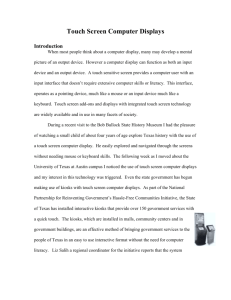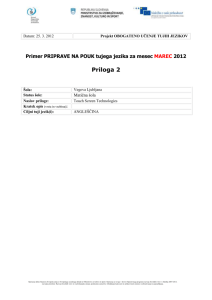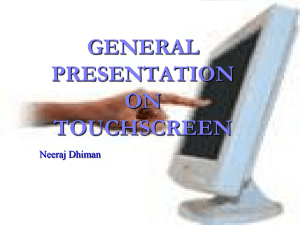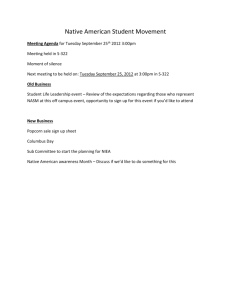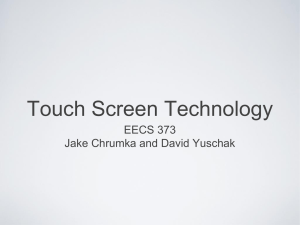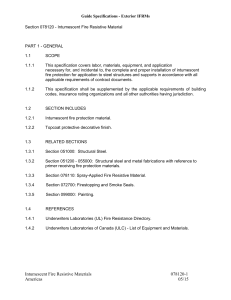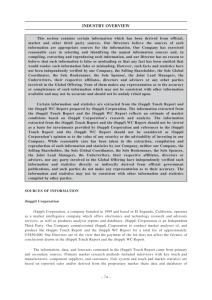Software Updates
advertisement
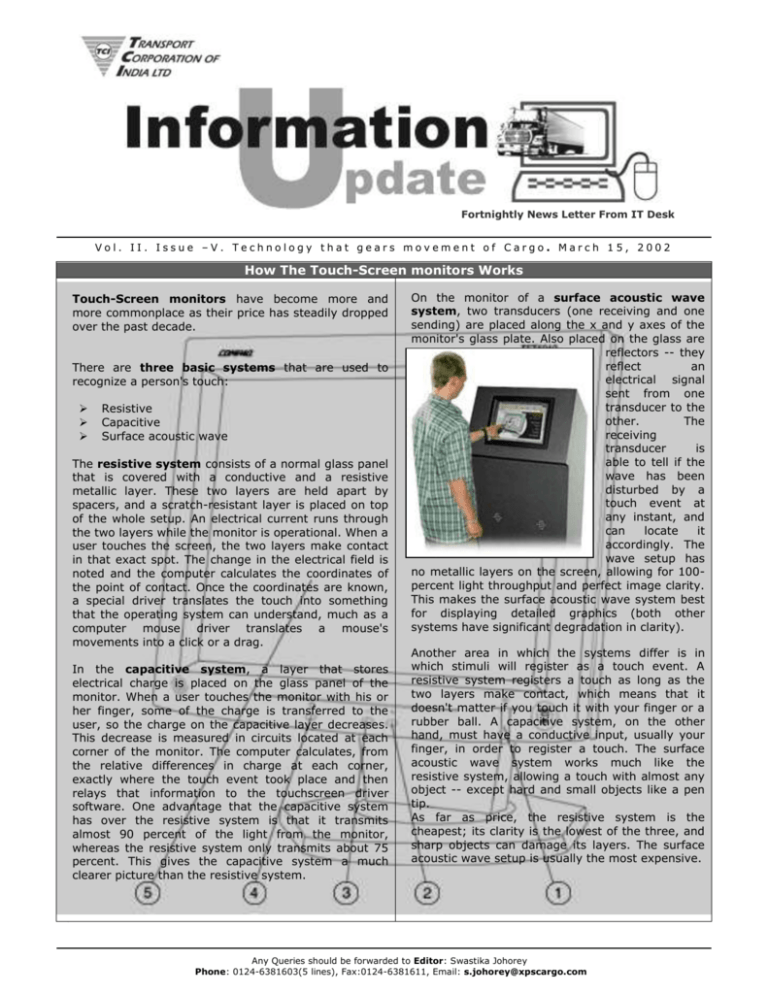
Fortnightly News Letter From IT Desk Vol. II. Issue –V. Technology that gears movement of Cargo. March 15, 2002 How The Touch-Screen monitors Works Touch-Screen monitors have become more and more commonplace as their price has steadily dropped over the past decade. There are three basic systems that are used to recognize a person's touch: Resistive Capacitive Surface acoustic wave The resistive system consists of a normal glass panel that is covered with a conductive and a resistive metallic layer. These two layers are held apart by spacers, and a scratch-resistant layer is placed on top of the whole setup. An electrical current runs through the two layers while the monitor is operational. When a user touches the screen, the two layers make contact in that exact spot. The change in the electrical field is noted and the computer calculates the coordinates of the point of contact. Once the coordinates are known, a special driver translates the touch into something that the operating system can understand, much as a computer mouse driver translates a mouse's movements into a click or a drag. In the capacitive system, a layer that stores electrical charge is placed on the glass panel of the monitor. When a user touches the monitor with his or her finger, some of the charge is transferred to the user, so the charge on the capacitive layer decreases. This decrease is measured in circuits located at each corner of the monitor. The computer calculates, from the relative differences in charge at each corner, exactly where the touch event took place and then relays that information to the touchscreen driver software. One advantage that the capacitive system has over the resistive system is that it transmits almost 90 percent of the light from the monitor, whereas the resistive system only transmits about 75 percent. This gives the capacitive system a much clearer picture than the resistive system. On the monitor of a surface acoustic wave system, two transducers (one receiving and one sending) are placed along the x and y axes of the monitor's glass plate. Also placed on the glass are reflectors -- they reflect an electrical signal sent from one transducer to the other. The receiving transducer is able to tell if the wave has been disturbed by a touch event at any instant, and can locate it accordingly. The wave setup has no metallic layers on the screen, allowing for 100percent light throughput and perfect image clarity. This makes the surface acoustic wave system best for displaying detailed graphics (both other systems have significant degradation in clarity). Another area in which the systems differ is in which stimuli will register as a touch event. A resistive system registers a touch as long as the two layers make contact, which means that it doesn't matter if you touch it with your finger or a rubber ball. A capacitive system, on the other hand, must have a conductive input, usually your finger, in order to register a touch. The surface acoustic wave system works much like the resistive system, allowing a touch with almost any object -- except hard and small objects like a pen tip. As far as price, the resistive system is the cheapest; its clarity is the lowest of the three, and sharp objects can damage its layers. The surface acoustic wave setup is usually the most expensive. 7 Any Queries should be forwarded to Editor: Swastika Johorey Phone: 0124-6381603(5 lines), Fax:0124-6381611, Email: s.johorey@xpscargo.com Your Attention Please!!! Whenever you boot the system or switch on the PC please ensure to give the username and password to login to the local Novell server otherwise there will be problems in data transfer in Oracle. All must ensure at the time when LHC is being prepared at non-computerized locations, the person who is making LHC must write the LHC NO. by hand also because the No. on the carbon less copies is not visible due to stationery problem due to which lot of wrong entries are being done at the final payment station. AHRO, BBRO, HYRO Regional officers are requested to see why CBS data coming through RPIS is wrong. Many times it has been informed to copy the latest Petty Cash Form which is the main cause of erroneous data but, regret to say none of the Petrol Pumps have copied the same. Immediately give us the reason for the same. As there is very small changes in TIPS, the CD of this month is not being send. New Voucher forms will be sent through mail. Any kind of problems/query should be directed to sudesh.jain@tcil.com. Numeric No. for all secondary documents to be introduced and implemented from 1st April, 2002. Introducing Zero MR for all dockets as a gate for delivery. Tight Spots: Area of concern and possible solutions for Installing & Running the ftp_int.exe Make a folder in your c drive md c:\ftp Copy the ftp_int.exe from HECL server from \xcrp\xcrp folder into c:\ftp Send DBR data on daily basis without fail. After installation user has to c:\windows\system directory Challan data/DWB data/POD data/VTS data should be sent on priority basis. After that we have to put the ftp_int.exe in the scheduler & set the timing of running after 30 mins/1 hour Sprint RPG discontinued. First time when this program will run then it will ask for following parameters. Oracle implementation started at Accounting centers (XALD, XLKO) with Delhi region & from April it will start for other regions. As this is the end of financial year. The month end data must reach as earliest. For oracle site – Please write to us in case of any problem even if minor. Any kind of problems/query should be directed to k.bhattacharjee@xpscargo.com. Server Address User Name Password copy the msinet.ocx file into \\xpsxcrp\data (for network m/c) Or C: (for standalone m/c) ????vsat password Where xpsxcrp is server name & data is the volume name of the server. User name is the ftp id Password is the ftp id’s password Just make sure that before running this program your system should be connected to the Internet. (Through dial up networking/leased line) & user logged into your local server. New Arrivals Appreciation Thanks to all Regional Officers for regularly sending the Weekly Feed Back Form. Please keep it up Alpha numeric to numeric: Software for Numeric Nos. for all secondary documents will be released from 01/04/2002. Automatic creation of OTO dump along with CBS preparation without any manual intervention has already been tested & implemented at DLH & UPB. Mr. Rohit Pant had given the training for installation of the same at VNP. All the Regional Officers are requested to immediately get the same implemented at all your controllings. Branch Computerisation software in Visual Basic is under testing at GGN The scheduled Time for sending data through FTP to reduce the data traffic is as follows. Check your Time Region and its Controlling TCI XPS AHRO, BBRO XARO, XKRO BNRO, CARO XBRO, XCRO DLRO, HYRO XDRO MDRO, VNRO XPRO Time 11:00AM TO 12:00PM 12:00PM TO 1:00 PM 3:00PM TO 4:00PM 4:00PM TO 5:00PM Note: Please ask all of your controllings to strictly follow the same as it chocks the bandwidth and reducing the speed of data transfer. Anybody missing this scheduled should do it after 6:30 PM. Any Queries should be forwarded to Editor: Swastika Johorey Phone: 0124-6381603(5 lines), Fax:0124-6381611, Email: s.johorey@xpscargo.com
